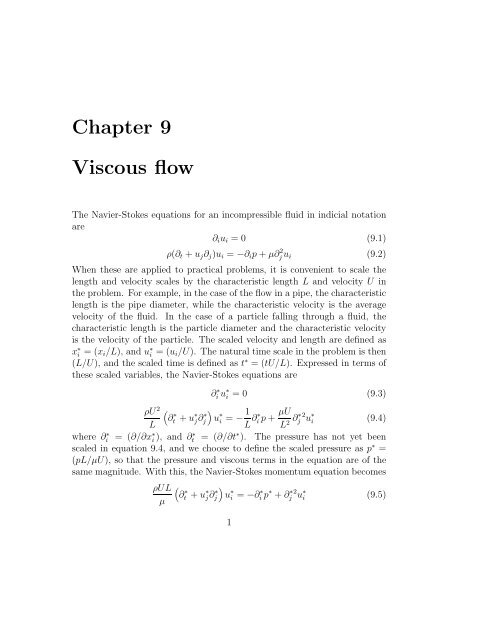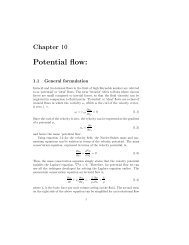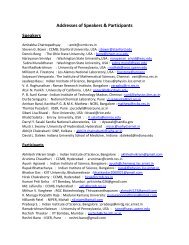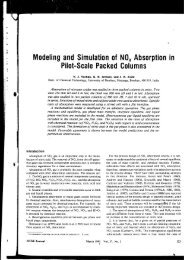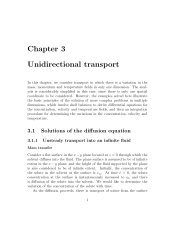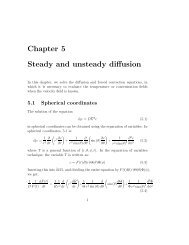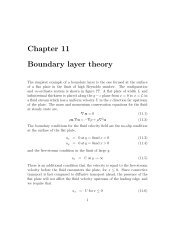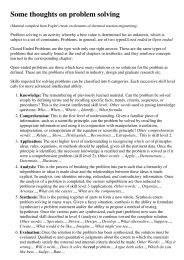You also want an ePaper? Increase the reach of your titles
YUMPU automatically turns print PDFs into web optimized ePapers that Google loves.
<strong>Chapter</strong> 9<br />
<strong>Viscous</strong> <strong>flow</strong><br />
The Navier-Stokes equations for an incompressible fluid in indicial notation<br />
are<br />
∂ i u i = 0 (9.1)<br />
ρ(∂ t + u j ∂ j )u i = −∂ i p + µ∂ 2 j u i (9.2)<br />
When these are applied to practical problems, it is convenient to scale the<br />
length and velocity scales by the characteristic length L and velocity U in<br />
the problem. For example, in the case of the <strong>flow</strong> in a pipe, the characteristic<br />
length is the pipe diameter, while the characteristic velocity is the average<br />
velocity of the fluid. In the case of a particle falling through a fluid, the<br />
characteristic length is the particle diameter and the characteristic velocity<br />
is the velocity of the particle. The scaled velocity and length are defined as<br />
x ∗ i = (x i /L), and u ∗ i = (u i /U). The natural time scale in the problem is then<br />
(L/U), and the scaled time is defined as t ∗ = (tU/L). Expressed in terms of<br />
these scaled variables, the Navier-Stokes equations are<br />
∂ ∗ i u∗ i = 0 (9.3)<br />
ρU 2 ( )<br />
∂<br />
∗<br />
L t + u ∗ j ∂∗ j u<br />
∗<br />
i = − 1 L ∂∗ i p + µU<br />
L 2 ∂∗ j 2 u ∗ i (9.4)<br />
where ∂i ∗ = (∂/∂x ∗ i ), and ∂∗ t = (∂/∂t ∗ ). The pressure has not yet been<br />
scaled in equation 9.4, and we choose to define the scaled pressure as p ∗ =<br />
(pL/µU), so that the pressure and viscous terms in the equation are of the<br />
same magnitude. With this, the Navier-Stokes momentum equation becomes<br />
ρUL<br />
µ<br />
(<br />
∂<br />
∗<br />
t + u ∗ j∂ ∗ j<br />
)<br />
u<br />
∗<br />
i = −∂ ∗ i p ∗ + ∂ ∗ j 2 u ∗ i (9.5)<br />
1
2 CHAPTER 9. VISCOUS FLOW<br />
The dimensionless number (ρUL/µ) is the Reynolds number, which provides<br />
the ratio of convection and diffusion for the fluid <strong>flow</strong>. This can also be<br />
written as (UL/ν), where nu = (µ/ρ) is the kinematic viscosity or momentum<br />
diffusivty.<br />
When the Reynolds number is small, the convective terms in the momentum<br />
equation 9.5 can be neglected in comparison to the viscous terms<br />
on the right side of 9.5. The Navier-Stokes equations reduce to the ‘Stokes<br />
equations’ in this limit,<br />
∂ i u i = 0 (9.6)<br />
−∂ i p + µ∂ 2 j u i = 0 (9.7)<br />
The Stokes equations have two important properties — they are linear, since<br />
both the equations are linear in the velocity u i , and they are quasi-steady,<br />
since there are no time derivatives in the Stokes equations. The absence of<br />
time derivatives in the governing equations implies that the velocity field<br />
due to the forces exerted on the fluid depend only on the instanteneous value<br />
of the forces, or the velocity boundary conditions at the surfaces bounding<br />
the fluid, and not the time history of the forces exerted on the fluid. For<br />
example, in order to determine the velocity field due to force exerted by a<br />
sphere falling through a fluid, it is sufficient to know the instanteneous value<br />
of the velocity of the sphere, and it is not necessary to know the details of<br />
the previous evolution of the velocity of the sphere. This is because the <strong>flow</strong><br />
is diffusion dominated, and it is assumed that diffusion is instanteneous at<br />
zero Reynolds number. A similar feature is encountered in the solution for<br />
the diffusion equation in the limit of low Peclet number, where convective<br />
effects are neglected.<br />
D∇ 2 c = 0 (9.8)<br />
In this case, the concentration field is determined at any instant if the value<br />
of the boundary conditions at the bounding surfaces are know, and it is not<br />
necessary to know the previous evolution of the previous evolution of the<br />
concentration at the bounding surfaces.<br />
Diffusion is not instanteneous in reality, of course, and there is a distance<br />
beyond which the assumption of instanteneous diffusion is not valid. For<br />
example, consider the case of a sphere settling through a fluid. Though<br />
diffusion is fast compared to convection over lengths comparable to the sphere<br />
diameter in the limit of low Reynolds number, it is expected that there is<br />
some larger length over which diffusion is not instanteneous, and convective
9.1. SPHERICAL HARMONIC SOLUTIONS 3<br />
effects become important. This ‘diffusion length’ L D can be estimated by<br />
balancing the convective and diffusive terms in the momentum equation,<br />
ρu j ∂ j u i ∼ (ρU 2 /L D )<br />
µ∂ 2 j u i ∼ (µU/L D ) (9.9)<br />
A balance between these two indicates that L D ∼ (µ/ρU), or (L D /L) ∼ Re −1 .<br />
Thus, convective effects become important when the ratio of the distance<br />
from the sphere and the sphere radius is large compared to Re −1 .<br />
The linearity of the Stokes equations has some useful consequences. For<br />
example linearity can be used to deduce that if the force exerted by a surface<br />
on a fluid is reversed, then the fluid velocity field is also exactly reversed at<br />
all points in the fluid, as shown in figure 9.1. This is called the ‘Stokes <strong>flow</strong><br />
reversibility’. Similarly, if the force exerted by the surfaces on the sphere<br />
is reduced by a factor of 2, then the fluid velocity is also reduced by a<br />
factor of 2 at all points. In addition, linear superposition can be used to<br />
separate a problem into smaller sub-problems, and then add up the results.<br />
For example, consider a sphere moving in a fluid as shown in figure 9.2. This<br />
problem can be separated into three sub-problems, each of which consists<br />
of a sphere which has a velocity along one of the coordinate axes, with the<br />
stipulation that the sum of the three velocity vectors is equal to the velocity<br />
of the sphere in the original problem. The velocity fields in each of these<br />
three sub-problems are calculated, and are added up in order to obtain the<br />
velocity field in the original problem.<br />
9.1 Spherical harmonic solutions<br />
The Stokes equations can be written as two Laplace equations for the pressure<br />
and the velocity fields by taking the divergence of the momentum equation<br />
9.7.<br />
∂ i (−∂ i p + µ∂ 2 j u i)<br />
= −∂ 2 i p + µ∂ 2 j∂ i u i<br />
= −∂ 2 i p (9.10)<br />
Equation 9.10 indicates that the Laplacian of the pressure field is identically<br />
zero,<br />
∂ 2 i p = 0 (9.11)
4 CHAPTER 9. VISCOUS FLOW<br />
x<br />
2<br />
x<br />
2<br />
x<br />
3<br />
x<br />
x<br />
1<br />
x<br />
1<br />
(a)<br />
(b)<br />
Figure 9.1: When the force exerted on the fluid is reversed, the fluid velocity<br />
is reversed at all points in Stokes <strong>flow</strong>.
9.1. SPHERICAL HARMONIC SOLUTIONS 5<br />
x<br />
2<br />
x<br />
3<br />
x<br />
1<br />
(a)<br />
x<br />
2<br />
x<br />
2<br />
x<br />
2<br />
x<br />
3<br />
x<br />
3<br />
x<br />
1<br />
x1<br />
x1<br />
(b) (c) (d)<br />
Figure 9.2: Use of linear superposition for separating the problem into simpler<br />
sub-problems.
6 CHAPTER 9. VISCOUS FLOW<br />
The velocity field in the momentum equation can be separated into two<br />
parties, a ‘homogeneous solution’ which satisfies<br />
and a particular solution which satisfies<br />
∂ 2 i u (h)<br />
i = 0 (9.12)<br />
µ∂ 2 i u(p) i = ∂ i p (9.13)<br />
The particular solution is any one solution to the equation 9.13. One solution<br />
which satisfies equation 9.13 is<br />
u (p)<br />
i = 1<br />
2µ px i (9.14)<br />
This solution can be verified as follows. If we take the gradient of the particular<br />
solution 9.14, we get<br />
∂ j u (p)<br />
i = 1<br />
2µ (x i∂ j p + pδ ij ) (9.15)<br />
Upon taking the divergence of the above equation, we get<br />
∂j 2 u(p) i = 1<br />
2µ (2δ ij∂ j p + x i ∂j 2 p)<br />
= 1 µ ∂ ip (9.16)<br />
Therefore, the velocity fields can be obtained by solving the Laplace equation<br />
for the pressure and the homogeneous part of the velocity fields, and using<br />
equation 9.16 to obtain the particular part of the velocity field.<br />
We have already studied the solution for the Laplace equation,<br />
∇ 2 φ = 0 (9.17)<br />
which are obtained using separation of variables. In the present chapter, we<br />
derive the same solutions using the more convenient indicial notation. The<br />
fundamental solution for the Laplace equation in three dimensions, correct<br />
to within a multiplicative constant (which is determined from the boundary<br />
conditions, is<br />
Φ (0) = 1 r<br />
(9.18)
9.1. SPHERICAL HARMONIC SOLUTIONS 7<br />
A series of solutions can be derived from equation 9.18 as follows. If we take<br />
the gradient of equation 9.18, we get<br />
∂<br />
∇ 2 φ = ∇ 2 ∂φ = 0 (9.19)<br />
∂x i ∂x i<br />
Therefore, if φ is a solution of the Laplace equation, then its gradient (∂φ/∂x i )<br />
is also a solution of the Laplace equation. The gradient of the fundamental<br />
solution is given by<br />
∂Φ (0)<br />
∂x i<br />
=<br />
(<br />
)<br />
∂ ∂ ∂ 1<br />
e 1 + e 2 + e 3<br />
∂x 1 ∂x 2 ∂x 3 (x 2 1 + x 2 2 + x 2 3) 1/2<br />
= − e 1x 1 + e 2 x 2 + e 3 x 3<br />
(x 2 1 + x 2 2 + x 2 3) 3/2<br />
= − x i<br />
r 3 (9.20)<br />
Therefore, the second solution for the Laplace equation, which is proportional<br />
to the gradient of the first, is<br />
Φ (1)<br />
i<br />
= x i<br />
r 3 (9.21)<br />
The third solution can be obtained by taking the gradient of the second<br />
solution,<br />
Φ (2)<br />
ij<br />
= ∂Φ(1) i<br />
∂x j<br />
= ∂ ( ) xi<br />
∂x j r<br />
(<br />
δij<br />
=<br />
r − 3x )<br />
ix j<br />
r 3<br />
(9.22)<br />
It can easily be verified that the above solutions are linear combinations of<br />
the spherical harmonic solutions obtained by separation of variables. For<br />
example, the three components of Φ (1)<br />
i are<br />
Φ (1)<br />
3 = x 3<br />
r 3
8 CHAPTER 9. VISCOUS FLOW<br />
cos (θ)<br />
=<br />
r 2<br />
= r −2 P1 0 (cos (θ))<br />
Φ (1)<br />
1 = x 1<br />
r 3<br />
sin (θ) cos (φ)<br />
=<br />
r 2<br />
= r −2 P1 1 (cos (θ))((exp (ıφ) + exp (−ıφ))/2<br />
Φ (1)<br />
2 = x 2<br />
=<br />
r 3<br />
sin (θ) sin (φ)<br />
r 2<br />
= r −2 P1 1 (cos (θ))((exp (ıφ) − exp (−ıφ))/(2ı) (9.23)<br />
Similarly, it can be verified that the elements of the second solution Φ (2)<br />
ij are<br />
linear combinations of the second solution obtained from spherical harmonics,<br />
(1/r 3 )P3 m (cos (θ)) exp (ımφ). First note that the tensor Φ (2)<br />
ij is a symmetric<br />
tensor traceless tensor, and the sum of the diagonal elements is identically<br />
equal to zero. Therefore, there are five independent elements in this tensor,<br />
which correspond to the five solutions of the second spherical harmonic for<br />
m = 0, ±1, ±2. The component Φ (2)<br />
Φ (2)<br />
33 =<br />
33 is<br />
( ) 1<br />
r − 3x2 3<br />
3 r 5<br />
= 1 r 3(1 − 3 cos (θ)2 )<br />
= − 2P 3 0 (cos (θ))<br />
(9.24)<br />
r 3<br />
Similarly, the correspondence between the other elements of Φ (2)<br />
ij and the<br />
other spherical harmonic solutions can be shown.<br />
The growing spherical harmonic solutions are obtained by multiplying<br />
the decaying solutions by r 2n+1 , to obtain the series<br />
Φ (0) = 1<br />
= x i<br />
Φ (2) = r 2 δ ij + 3x i x j (9.25)<br />
Φ (1)<br />
The solutions for the homogeneous part of the velocity field and the pressure<br />
field are linear combinations of the growing and decaying solutions.
9.1. SPHERICAL HARMONIC SOLUTIONS 9<br />
9.1.1 Force on a settling sphere<br />
In this section, we use the spherical harmonic expansion in order to determine<br />
for force exerted on a sphere settling in a fluid. The sphere is considered to be<br />
of unit radius, so that all length scales in the problem are scaled by the radius<br />
of the sphere. The sphere has a velocity U, and the boundary conditions at<br />
the surface of the sphere are that the fluid velocity is equal to the velocity<br />
of the sphere,<br />
u i = U i at r = 1 (9.26)<br />
while the velocity decreases to zero at a large distance from the center of the<br />
sphere.<br />
We use a spherical coordinate system, where the origin of the coordinate<br />
system is fixed at the center of the sphere, as shown in figure 9.3. Since the<br />
Stokes equations are linear, the fluid velocity and pressure fields are linear<br />
functions of the velocity U i of the sphere. In addition, the homogeneous<br />
solution for the velocity field and the pressure are solutions of the Laplace<br />
equation, and so these are in the form of spherical harmonics given in 9.18,<br />
9.20, 9.22 and the higher harmonics. The only linear combinations of the<br />
velocity of the sphere U i and the spherical harmonic solutions which can<br />
result in a velocity vector are<br />
(<br />
u (h) 1<br />
i = A 1 U i<br />
r + A δij<br />
2U j<br />
r − 3x )<br />
ix j<br />
3 r 5<br />
(9.27)<br />
where A 1 and A 2 are constants. Similarly, the only linear combinations of<br />
the velocity vector and the spherical harmonic solutions which can result in<br />
the scalar pressure is<br />
p = A 3 U j<br />
x j<br />
r 3 (9.28)<br />
where A 3 is a constant. The total velocity field is the sum of the homogeneous<br />
and particular parts,<br />
(<br />
1<br />
u i = A 1 U i<br />
r + A δij<br />
2U j<br />
r − 3x )<br />
ix j<br />
+ A 3x i U j x j<br />
(9.29)<br />
3 r 5 2µ r 3<br />
The values of the constants A 1 , A 2 and A 3 are determined from the boundary<br />
conditions at the surface of the sphere, 9.26, as well as the incompressibility<br />
condition 9.1 which has not been enforced yet. The incompressibility
10 CHAPTER 9. VISCOUS FLOW<br />
x<br />
3<br />
x 1<br />
x 2<br />
g<br />
U<br />
Figure 9.3: Sphere settling in a fluid.<br />
condition (∂u i /∂x i ) = 0 can be simplified as<br />
∂u i<br />
∂x i<br />
(<br />
∂ 1 ∂<br />
= A 1 U i<br />
∂x i r + A δ ij<br />
2U j<br />
∂x i r − 3 ∂ )<br />
x i x j<br />
+ A 3U j<br />
3 ∂x i r 5 2µ<br />
= − A 1U i x i<br />
r 3 + A 2 U j<br />
(<br />
+ A 3U j<br />
2µ<br />
= − A 1U i x i<br />
r 3<br />
(<br />
δii x j<br />
r 3<br />
+ δ ijx i<br />
r 3<br />
− 3δ ijx i<br />
r 5<br />
− 3δ ijx i<br />
r 5<br />
− 3x2 i x )<br />
j<br />
r 5<br />
− 3δ iix j<br />
r 5<br />
∂ x i x j<br />
∂x i r 3<br />
)<br />
+ 15x2 ix j<br />
r 7<br />
+ A 3U j x j<br />
2µr 3 (9.30)<br />
In simplifying equation 9.30, we have used x 2 i = (x 2 1+x 2 2+x 2 3) = r 2 . Therefore,<br />
from the incompressibility condition, we get A 1 = (A 3 /2µ). Inserting this<br />
into equation 9.30, the velocity field is<br />
(<br />
δij<br />
u i = A 1 U j<br />
r + x ) (<br />
ix j δij<br />
+ A<br />
r 3 2 U j<br />
r − 3x )<br />
ix j<br />
(9.31)<br />
3 r 5<br />
The constants A 1 and A 2 are determined from the boundary condition at the<br />
surface of the sphere (r = 1),<br />
u i | r=1<br />
= A 1 U i + A 1 U j x i x j + A 2 U i − 3A 2 U j x i x j<br />
= U i (9.32)<br />
From this, we get two equations for A 1 and A 2 ,<br />
A 1 + A 2 = 1<br />
A 1 − 3A 2 = 0 (9.33)
9.1. SPHERICAL HARMONIC SOLUTIONS 11<br />
These can be solved to obtain<br />
A 1 = 3 4<br />
A 2 = 1 4<br />
(9.34)<br />
The final solution for the velocity field is<br />
u i = 3U (<br />
j δij<br />
4 r + x )<br />
ix j<br />
+ U j<br />
r 3 4<br />
while the pressure is<br />
(<br />
δij<br />
r − 3x )<br />
ix j<br />
3 r 5<br />
(9.35)<br />
p = 3µU jx j<br />
(9.36)<br />
2r 3<br />
The force exerted on the sphere is given by<br />
∫<br />
F i = dST ik n k<br />
S<br />
∫<br />
= dS(−pn i + τ ik n k ) (9.37)<br />
The shear stress is τ ik = µ((∂u i /∂x k ) + (∂u k /∂x k )). The gradient of the<br />
velocity field, (∂u i /∂x k ), can be determined as follows,<br />
∂u i<br />
= 3U (<br />
j<br />
− δ ijx k<br />
+ δ ikx j<br />
+ δ jkx i<br />
− 3x )<br />
ix j x k<br />
∂x k 4 r 3 r 3 r 3 r 5<br />
+ U (<br />
j<br />
− 3δ ijx k<br />
− 3δ ikx j<br />
− 3δ jkx i<br />
+ 15x )<br />
ix j x k<br />
(9.38)<br />
4 r 5 r 5 r 5 r 7<br />
The gradient (∂u k /∂x i ) is obtained by interchanging the indices i and k in<br />
equation 9.38,<br />
∂u k<br />
= 3U (<br />
j<br />
− δ kjx i<br />
+ δ ikx j<br />
+ δ ijx k<br />
− 3x )<br />
ix j x k<br />
∂x i 4 r 3 r 3 r 3 r 5<br />
+ U (<br />
j<br />
− 3δ jkx i<br />
− 3δ ikx j<br />
− 3δ ijx k<br />
+ 15x )<br />
ix j x k<br />
(9.39)<br />
4 r 5 r 5 r 5 r 7<br />
Adding these two contributions and multiplying by the viscosity, and setting<br />
the radius equal to 1 at the surface of the sphere, we get<br />
( 3Uj<br />
τ ik = µ<br />
2 (δ ikx j − 3x i x j x k )<br />
+ U j<br />
2 (−3δ ijx k − 3δ ik x j − 3δ jk x i + 15x i x j x k )<br />
)<br />
(9.40)
12 CHAPTER 9. VISCOUS FLOW<br />
The unit normal to the surface of the sphere, n i is also equal to the ratio of<br />
the displacement vector and the radius, n i = (x i /r). Since the radius is 1 on<br />
the surface of the sphere, n i = x i . Therefore, the dot product of the stress<br />
tensor and the unit normal is<br />
( 3Uj<br />
τ ik n k = µ<br />
2 (x ix j − 3x i x j x 2 k )<br />
+ U )<br />
j<br />
2 (−3δ ijx 2 k − 6x ix j + 15x i x j x 2 k )<br />
(<br />
= µ − 3U i<br />
2 + 3U )<br />
jx i x j<br />
(9.41)<br />
2<br />
The contribution to the force on the sphere due to the pressure is given by<br />
−pn i | r=1<br />
= − 3µU jx i x j<br />
2<br />
Adding up these two contributions, we get<br />
(9.42)<br />
T ij n j = − 3U i<br />
2<br />
(9.43)<br />
Since the right side of 9.43 is independent of position on the surface of the<br />
sphere, the total force is the product of T ij n j and the surface area of the<br />
sphere, which is 4π for a sphere of unit radius.<br />
F i = 6πµU i (9.44)<br />
For a sphere of radius R, the dependence of the force on the radius is deduced<br />
on the basis of dimensional analysis,<br />
F i = 6πµRU i (9.45)<br />
9.1.2 Effective viscosity of a suspension<br />
A shear <strong>flow</strong> is applied to a suspension which consists of solid particles with<br />
radius R and volume fraction φ suspended in a fluid of viscosity µ, as shown<br />
in figure 9.4(a). We will assume, for simplicity, that the suspension is dilute,<br />
so that the disturbance to the <strong>flow</strong> due to one particle does not affect<br />
the surrounding particles. We would like to derive an average constitutive<br />
relation for the suspension of the form<br />
〈T ij 〉 = −〈p〉δ ij + 2µ eff 〈E ij 〉 (9.46)
9.1. SPHERICAL HARMONIC SOLUTIONS 13<br />
(a)<br />
(b)<br />
Figure 9.4: Shear <strong>flow</strong> of a suspension (a) and the shear <strong>flow</strong> around a particle<br />
(b).
14 CHAPTER 9. VISCOUS FLOW<br />
where µ eff is the effective viscosity of the suspension, and 〈〉 is a volume<br />
average over the entire volume of the suspension.<br />
The volume averaged symmetric traceless part of the stress tensor can be<br />
expressed as<br />
〈τ ij 〉 = 1 ∫<br />
dV τ ij<br />
V V suspension<br />
⎛<br />
⎞<br />
= 1 ∫<br />
∫<br />
⎝ dV (2µE ij ) + dV (τ ij − 2µE ij ) ⎠<br />
V V suspension<br />
V suspension<br />
= 2µ〈E ij 〉 + 1 ∫<br />
dV (τ ij − 2µE ij ) (9.47)<br />
V V suspension<br />
The second term on the right side of 9.47 is identically equal to zero for the<br />
fluid, from the constitutive equation. Therefore, the second integral reduces<br />
to an integral over the particles,<br />
〈τ ij 〉 = 2µ〈E ij 〉 + 1 ∫<br />
dV (τ ij − 2µE ij ) (9.48)<br />
V V particles<br />
In order to determine the effective viscosity, it is sufficient to consider the<br />
symmetric traceless part of the above equation. Further, if the particles are<br />
solid, the rate of deformation E ij within the particles is identically equal to<br />
zero. Therefore, the symmetric traceless part of the above equation reduces<br />
to<br />
〈τ ij 〉 = 2µ〈E ij 〉 + N ∫<br />
dV (τ ij − 2µE ij ) (9.49)<br />
V V 1 particles<br />
= 2µ〈E ij 〉 + N ∫<br />
dV τ ij (9.50)<br />
V V 1 particle<br />
∫<br />
φ<br />
= 2µ〈E ij 〉 +<br />
dV τ<br />
(4πR 3 ij (9.51)<br />
/3) V 1 particle<br />
In deriving equation 9.51 from 9.50, we have used the simplification that the<br />
number of particles per unit volume is the ratio of the volume fraction and<br />
the volume of a particle. The second term on the right side of equation 9.51<br />
can be simplified as follows. Consider the divergence of (τ il x j ),<br />
∂τ il x j<br />
∂x l<br />
= τ il δ lj + x j<br />
∂τ il<br />
∂x l<br />
(9.52)
9.1. SPHERICAL HARMONIC SOLUTIONS 15<br />
∂τ il<br />
= τ ij + x j<br />
∂x l<br />
(9.53)<br />
= τ ij (9.54)<br />
The divergence of the stress tensor, in the right side of equation 9.53, is zero<br />
if inertial effects are neglected, and therefore, the integral on the right side<br />
of equation 9.51 can be written as<br />
∫<br />
dV τ ij =<br />
V 1 particle<br />
=<br />
∫<br />
dV ∂τ ilx j<br />
V 1 particle<br />
∂x l<br />
∫<br />
dSn l τ il x j (9.55)<br />
S 1 particle<br />
The surface integral on the right side of equation 9.55 can be calculated<br />
using the spherical harmonic expansion, considering a sphere placed in a<br />
linear shear <strong>flow</strong> in which the fluid velocity at a large distance from the<br />
sphere, u ∞ i = E ij x j . The fluid velocity field at a large distance from the<br />
sphere is given by<br />
and the pressure is<br />
u i = E ij x j<br />
(<br />
)<br />
1 − R5<br />
+ 5x ( )<br />
ix j x k E jk R<br />
5<br />
r 5 2 r − R3<br />
7 r 5<br />
(9.56)<br />
p = 5µR3 x j x k E jk<br />
r 5 (9.57)<br />
Using this, the surface integral on the left side of equation 9.55 can be calculated,<br />
∫<br />
dSn l τ il x j<br />
S 1 particle<br />
With this, we get the effective shear stress<br />
= 20πR3 µE ij<br />
3<br />
〈τ ij 〉 = 2µE ij + 5φµE ij<br />
( )<br />
= 2µ<br />
1 + 5φ 2<br />
(9.58)<br />
E ij (9.59)<br />
Therefore, the effective viscosity is given by µ eff = µ(1 + 5φ/2).
16 CHAPTER 9. VISCOUS FLOW<br />
Exercise: Show that the velocity and pressure fields due to a sphere of<br />
radius R rotating with angular velocity Ω in a fluid which is at rest a large<br />
distance from the sphere is,<br />
u i = ǫ ijk Ω j x k<br />
( R<br />
r<br />
) 3<br />
p = 0 (9.60)<br />
Show that the exerted by the sphere on the fluid is,<br />
L i = −8πµR 3 Ω i (9.61)<br />
Hint: Note that the angular velocity is a pseudo-vector, and the velocity field<br />
and pressure are real.<br />
9.2 Green’s functions and Faxen’s laws:<br />
9.2.1 Oseen tensor for a point force:<br />
Since the Stokes equations are linear equations, it is possible to obtain<br />
Green’s function formulations for the velocity field similar to those obtained<br />
for the temperature field in steady state heat conduction. We briefly revisit<br />
the solution for the conduction equation in chapter , and then we present<br />
the analogous solution for the Stokes equations. In chapter , we solved the<br />
conduction equation,<br />
−k∇ 2 T = Qδ(r − r s ) (9.62)<br />
to obtain the temperature field,<br />
T(r) =<br />
Q<br />
4πK|r − r s |<br />
(9.63)<br />
where r s is the location of the source point. In order to obtain the Green’s<br />
function solution, we first obtained the temperature field for a sphere of<br />
radius R, and then took the limit R → 0 while keeping the heat flux Q finite.<br />
In viscous <strong>flow</strong>s, the equations equivalent of the Green’s function formulation<br />
9.87 are,<br />
∂ i u i = 0 (9.64)<br />
−∂ i p + µ∂ 2 j u i = F i δ(x − x s ) (9.65)<br />
where x s , the location of the force, is the ‘source point’. Note that the right<br />
side of equation 9.90 has dimensions of force per unit volume, since F i is the
9.2. GREEN’S FUNCTIONS AND FAXEN’S LAWS: 17<br />
total force exerted at the point x s , and the delta function has units of inverse<br />
volume.<br />
In order to solve equation 9.89 and 9.90, we can first solve for the velocity<br />
and pressure fields around a spherical particle of finite radius R, and then<br />
take the limit R → 0 while keeping the force F i finite. The solutions for the<br />
velocity and pressure fields were obtained in equations 9.35 and 9.36, and the<br />
force was obtained as a function of the translational velocity of the sphere in<br />
equation 9.44. If we use 9.44 to express the translational velocity in terms of<br />
the force in equations 9.35 and 9.36, we obtain,<br />
u i = F j<br />
8πµ<br />
while the pressure is<br />
(<br />
δij<br />
r + x )<br />
ix j<br />
+ F jR 2<br />
r 3 24π<br />
(<br />
δij<br />
r − 3x )<br />
ix j<br />
3 r 5<br />
(9.66)<br />
p = F jx j<br />
4πr 3 (9.67)<br />
When we take the limit R → 0, the first term on the right in equation 9.91<br />
remains finite while the second becomes negligible, while the term on the<br />
right side of equation 9.92 is finite. Therefore, the velocity and pressure<br />
fields at a field point x due to a point force F i exerted at the source point<br />
x (s) is,<br />
u i = J ij (x − x s )F j (x (s) )<br />
p = K i (x − x (s) )F i (x (s) ) (9.68)<br />
where the ‘Oseen tensors’, J ij and K i , are given by,<br />
J ij (x) = 1 (<br />
δij<br />
8πµ r + x )<br />
ix j<br />
r 3<br />
K i (x) = 1 x i<br />
(9.69)<br />
4π r 3<br />
where r = |x| is the distance from the source point to the field point.<br />
The linearity of the Stokes equations enables us to use superposition to<br />
find the velocity field due to multiple forces. For example, if the are N point<br />
forces F (n)<br />
i located at positions x (n) , where the index n varies from 1 to N,<br />
then the total velocity field is just the superposition of the velocity fields due<br />
to each of these forces,<br />
u i (x) =<br />
N∑<br />
n=1<br />
J ij (x − x (n) )F (n)<br />
j (x (n) )<br />
p(x) = K i (x − x (n) )F i (x (n) ) (9.70)
18 CHAPTER 9. VISCOUS FLOW<br />
Instead of having a discrete set of point forces, if we have a force distribution,<br />
in which the force per unit volume is given by f i (x), the velocity and pressure<br />
fields can be calculated by integrating the appropriate product of the Oseen<br />
tensor and the force distribution over the volume,<br />
∫<br />
u i (x) = dx ′ J ij (x − x ′ )f j (x ′ )<br />
∫<br />
p(x) = dx ′ K i (x − x ′ )F i (x ′ ) (9.71)<br />
9.2.2 Green’s function for force dipoles:<br />
There are often situations where the suspended particles in a fluid a ‘neutrally<br />
buoyant’, so that they exert no net force on the fluid. Examples are for a<br />
solid sphere in a uniform shear <strong>flow</strong> in equations and , and for a rotating<br />
particle in equations and . The velocity disturbance at a large distance<br />
from the center of the particle decays proportional to r −2 , in contrast to the<br />
decay proportional to r −1 in equation for the <strong>flow</strong> around a particle which<br />
exerts a net force on the fluid. The far-field velocity can be expressed as a<br />
function of the ‘force dipole moment’, which is defined as the integral over<br />
the sphere of the tensor product of the surface force and the position vector,<br />
∫<br />
Force dipole moment = dSx i f j<br />
∫<br />
= dSx i τ jk n k (9.72)<br />
Note that this definition is analogous to the ‘dipole moment’ for the temperature<br />
field due to a point dipole. The force dipole moment is a second<br />
order tensor, and it is convenient to separate it into a symmetric and an<br />
antisymmetric part. The symmetric part is given by,<br />
S ij = 1 ∫<br />
dS(x i τ jk n k + x j τ ik n k ) (9.73)<br />
2<br />
while the antisymmetric part is,<br />
A ij = 1 2<br />
∫<br />
dS(τ ik n k x j − τ jk n k x i ) (9.74)<br />
The velocity and pressure fields around a point particle which exerts no net<br />
force on the fluid can be expressed in terms of the symmetric and antisymmetric<br />
dipole moments S ij and A ij .
9.2. GREEN’S FUNCTIONS AND FAXEN’S LAWS: 19<br />
In the previous sub-section, we had derived the velocity field due to a<br />
point force by first solving the <strong>flow</strong> around a sphere of finite radius R, and<br />
then taking the limit R → 0 while keeping the force exerted a constant. The<br />
velocity field due to a force dipole can be obtained by first solving for the<br />
shear <strong>flow</strong> around a particle for radius R, and taking the limit of the radius<br />
going to zero while keeping the dipole moment fixed. First, we consider the<br />
symmetric dipole moment due to a sphere in a shear <strong>flow</strong>, for which the<br />
velocity and pressure fields are given by equations and . It can easily<br />
be shown, using symmetry considerations, that the net force exerted by the<br />
sphere on the fluid is identically zero. The symmetric force dipole due to the<br />
sphere is given by,<br />
S ij = 1 ∫<br />
dS(f i x j + x i f j )<br />
2 S<br />
= 1 ∫<br />
dS(τ il n l x j + τ jl n l x i ) (9.75)<br />
2 S<br />
The integrals on the right side of equation were already evaluated in<br />
equation , and the final result for the symmetric force dipole is,<br />
S ij<br />
= 20πµR3 E ij<br />
3<br />
(9.76)<br />
The rate of deformation tensor E ij can be written in terms of the symmetric<br />
force dipole using equation and substituted into equations and for<br />
the velocity and pressure fields.<br />
and the pressure is<br />
u i = E ij x j − 3S ijx j R 2<br />
20πµr 5<br />
+ 3x ix j x k S jk<br />
8πµ<br />
( ) R<br />
5<br />
r − R3<br />
7 r 5<br />
(9.77)<br />
p = 3x jx k S jk<br />
4r 5 (9.78)<br />
In equation , the first term on the right side is the imposed <strong>flow</strong> and not<br />
the disturbance due to the particle, and so we have not expressed this in<br />
terms of S ij . If we take the point particle limit R → 0 while keeping S ij<br />
a constant, we obtain the solution for the velocity field due to a symmetric<br />
point dipole,<br />
u i<br />
= E ij x j − 3S jkx i x j x k<br />
8πµr 5 (9.79)
20 CHAPTER 9. VISCOUS FLOW<br />
while the pressure field is given by equation .<br />
The response to an antisymmetric force dipole can be related to the torque<br />
exerted by the particle on the fluid, which is defined as,<br />
L i =<br />
∫<br />
S<br />
∫<br />
dSǫ ijk x j f k<br />
= 1 dSǫ ijk (x j f k − x k f j )<br />
2 S<br />
= ǫ ijk Djk A (9.80)<br />
where Djk A is the antisymmetric force dipole moment exerted by the particle.<br />
The torque is related to the angular velocity by equation , while the pressure<br />
is zero. Substituting for the particle velocity in terms of the torque, we<br />
obtain,<br />
9.2.3 Faxen’s laws<br />
u i = − ǫ ijkL j<br />
8πµ<br />
( xk<br />
r 3 )<br />
p = 0 (9.81)<br />
Faxen’s laws provide the velocity of a particle which is placed in some imposed<br />
<strong>flow</strong> field U ∞ (x). We have studied examples where the imposed <strong>flow</strong> field has<br />
a specific form; in section , the imposed <strong>flow</strong> field is a constant streaming<br />
<strong>flow</strong> around the particle, while in section , the imposed <strong>flow</strong> field is a linear<br />
shear <strong>flow</strong>. In this section, we examine the response of a spherical particle<br />
to an arbitrary imposed <strong>flow</strong> field, U ∞ (x), which is the velocity field at a<br />
large distance from the particle. This is a first step towards understanding<br />
inter-particle interactions, because if we know how the particle reacts to some<br />
imposed <strong>flow</strong> field, we can infer how it would react to the velocity disturbance<br />
caused by a second particle.<br />
The fluid velocity field due to a particle in the <strong>flow</strong> field U ∞ (x) can be<br />
expressed in terms of the surface forces using the Oseen tensor,<br />
u i (x) = U ∞ i (x) +<br />
= U ∞ i (x) +<br />
∫ ′<br />
S<br />
∫ ′<br />
S<br />
dS ′ J ij (x − x ′ )f j (x ′ )<br />
dS ′ J ij (x − x ′ )τ jk (x ′ )n ′ k (9.82)<br />
where x ′ is a point on the surface of the particle, S ′ is the surface of the<br />
particle and n ′ is the unit normal to the surface at the position x ′ . Equation<br />
also applies to the fluid velocity at the surface of the particle. The fluid
9.3. LUBRICATION FLOW 21<br />
velocity at a location on the surface, x ′′ , which is equal to the particle velocity<br />
at that location U + Ω × x ′′ , can be written as,<br />
U ∞ i (x ′′ ) +<br />
∫ ′<br />
S<br />
u i (x ′′ ) = U i + ǫ ijk Ω j x ′′<br />
k<br />
dS ′ J ij (x ′′ − x ′ )τ jk (x ′ )n ′ k (9.83)<br />
Here U is the translational velocity of the particle, and Ω is the rotational<br />
velocity. Note that in equation , both the field point x ′′ and the source<br />
point x ′ are located on the surface of the sphere. Now, we integrate the<br />
equation over the surface of the sphere, and use the no-slip condition at<br />
the surface which states that the fluid velocity u.<br />
∫<br />
∫ ∫<br />
4πR 2 U i = dS ′′ Ui ∞ (x ′′ ) + dS ′′ dS ′ J ij (x ′′ − x ′ )τ jk (x ′ )n ′ k (9.84)<br />
S<br />
S<br />
Note that the integral of the velocity due to partice rotation at the surface,<br />
∫<br />
S dS′′ ǫ ijk Ω j x ′′<br />
k is zero, since the integrand is an odd function of the position<br />
vector on the surface. The second term on the right side of equation can<br />
be simplified by changing the order of integration,<br />
∫ ∫<br />
∫<br />
∫<br />
dS ′′ dS ′ J ij (x ′′ − x ′ )τ jk (x ′ )n ′ k = dS ′ τ jk (x ′ )n ′ k dS ′′ J ij (x ′′ −(9.85)<br />
x ′ )<br />
S<br />
S<br />
The integral over S ′′ in equation , which is a constant independent of x ′ ,<br />
was shown to be equal to (2δ ij R/(3πµ)) in , and the integal ∫ S dS′ τ jk (x ′ )n ′ k<br />
is just the total force exerted by the sphere, F j . With this, equation <br />
simplifies to<br />
U i =<br />
S<br />
S<br />
F i<br />
6πµR<br />
∫S<br />
+ dS ′′ Ui ∞ (x ′′ ) (9.86)<br />
This is the integral form of the Faxen law for the velocity of a particle in an<br />
imposed velocity field U ∞ .<br />
9.3 Lubrication <strong>flow</strong><br />
The <strong>flow</strong> of fluids through thin layers between solid surfaces are referred to<br />
as ‘lubrication <strong>flow</strong>s’. These <strong>flow</strong>s are dominated by viscous effects, since the<br />
Reynolds number based on the relevant length scale, which is the distance<br />
between the solid surfaces, is small. The approach of the two surfaces requires<br />
S
22 CHAPTER 9. VISCOUS FLOW<br />
the fluid to be squeezed out of the gap between the surfaces, and the velocity<br />
of the fluid tangential to the surfaces is large compared to the velocity with<br />
which the surfaces approach each other. This results in large shear stresses<br />
in the gap, and a large resistance to the relative motion of the surfaces. This<br />
<strong>flow</strong> can be analysed using asymptotic analysis when the gap thickness is<br />
small. The lubrication <strong>flow</strong> generated due to a sphere approaching a solid<br />
surface is analysed in this section.<br />
The configuration, shown in figure 9.5, consists of a sphere of radius<br />
R approaching a plane surface with a velocity U. The minimum distance<br />
between the surface of the sphere and the plane surface is ǫR, where ǫ ≪ 1.<br />
A cylindrical coordinate system is used, since there is cylindrical symmetry<br />
about the perpendicular to the surface that passes through the center of<br />
the sphere, and the origin is fixed at the intersection between the axis of<br />
symmetry and the plane surface. There is no dependence on the polar angle<br />
in this problem, and so the velocity field is a function of the distance from<br />
the axis r and the height above the plane surface z. The plane surface is<br />
located at z = 0, while the equation for the surface of the sphere is given by<br />
((R(1 + ǫ) − z) 2 + r 2 ) 1/2 = R (9.87)<br />
Since ǫ is small, the above equation can be expanded in a Taylor series in ǫ.<br />
The equation for the bottom surface is<br />
R(1 + ǫ) − z = √ R 2 − r 2 (9.88)<br />
z = R(1 + ǫ) − √ R 2 − r 2 (9.89)<br />
We anticipate that r is also small compared to R in this region, and so the<br />
second term on the right side of equation 9.89 can be expanded in small<br />
r. When this expansion is carried out, and the first term in the series is<br />
retained, we get<br />
( )<br />
z = R(1 + ǫ) − R 1 − r2<br />
2R 2<br />
= Rǫ + r2<br />
2R<br />
Dividing throughout by Rǫ, the equation for the surface is<br />
(9.90)<br />
z<br />
Rǫ = 1 +<br />
r2<br />
(9.91)<br />
2R 2 ǫ 2
9.3. LUBRICATION FLOW 23<br />
R<br />
U<br />
z<br />
r<br />
r ε<br />
Figure 9.5: Lubrication <strong>flow</strong> in a small gap between a sphere and a solid<br />
surface.<br />
This equation suggests the use of the scaled coordinates z ∗ = (z/Rǫ)<br />
and r ∗ = (r/Rǫ 1/2 ). The equation for the surface in terms of these scaled<br />
coordinates is<br />
z ∗ = h(r ∗ ) = 1 + r∗2<br />
2<br />
(9.92)<br />
This is called the ‘parabolic approximation’ for the surface of the sphere. The<br />
scaling z ∗ = (z/Rǫ) is natural, since the fluid is in the domain 0 < z < Rǫ<br />
at r = 0. The scaling r ∗ = (r/Rǫ 1/2 ) arises because the slope (dr/dz) of the<br />
surface of the sphere is zero at r = 0, and so the surface can be approximated<br />
by a parabola around this point.<br />
Next, the components of the velocity in the fluid are scaled using the
24 CHAPTER 9. VISCOUS FLOW<br />
mass conservation equation.<br />
1 ∂(ru r )<br />
+ ∂u z<br />
r ∂r ∂z = 0 (9.93)<br />
The axial velocity u z can be scaled by the velocity of the surface of the sphere,<br />
U, since the axial velocity varies between 0 at the plane surface and −U at<br />
the surface of the sphere. When the mass conservation equation is expressed<br />
in terms of the scaled coordinates and the scaled velocity u ∗ z = (u z/U), we<br />
get<br />
1 1 ∂(r ∗ u r )<br />
+ U ∂u ∗ z<br />
Rǫ 1/2 r ∗ ∂r ∗ ǫR ∂z = 0 (9.94)<br />
∗<br />
The above equation provides the scaled for the radial velocity is u ∗ r = (u r ǫ 1/2 /U).<br />
This scaling indicates that when u ∗ r is O(1), the magnitude of the radial velocity<br />
is u r ∼ (U/ǫ 1/2 ), which is large compared to the magnitude of the axial<br />
velocity. This is because as the sphere moves downward, all the fluid displaced<br />
per unit time within a cylindrical section of radius r is πr 2 U. This fluid<br />
has to be expelled from the cylindrical surface with area 2πrh, and therefore<br />
the radial velocity scales as (Ur/h), which is proportional to (U/ǫ 1/2 ).<br />
The momentum conservation equations in the radial direction, expressed<br />
in terms of the scaled variables are<br />
ρU 2 ( ∂u<br />
∗<br />
r<br />
ǫ 3/2 ∂t + ∂u ∗<br />
∗ u∗ r<br />
r<br />
∂r + ∂u ∗ )<br />
∗ u∗ r<br />
z = − 1 (<br />
∂p U ∂ 2 u ∗<br />
∂z ∗ Rǫ 1/2 ∂r ∗+µ r<br />
R 2 ǫ 5/2 ∂z + U<br />
)<br />
1 ∂ r<br />
∗2 R 2 ǫ 3/2 r ∗ ∂r ∗r∗∂u∗ ∂r ∗<br />
(9.95)<br />
In the above equation, the scaled time has been defined as t ∗ = (tǫR/U),<br />
since the relevant time scale is the ratio of the gap width and the velocity<br />
of the sphere. This ensures that the first term on the left side of equation<br />
9.95 is of the same magnitude as the other three terms. The momentum<br />
conservation can be simplified by dividing throughout by the coefficient of<br />
the largest viscous term, which is proportional to (µU/R 2 ǫ 5/2 ),<br />
(<br />
ρURǫ ∂u<br />
∗<br />
r<br />
µ ∂t + ∂u ∗<br />
∗ u∗ r<br />
r<br />
∂r + ∂u ∗ )<br />
( ∗ u∗ r<br />
z = − Rǫ2 ∂p ∂ 2<br />
∂z ∗ µU ∂r + u ∗ r<br />
∗ ∂z + ǫ )<br />
∂ r<br />
∗2 r ∗ ∂r ∗r∗∂u∗ ∂r ∗ (9.96)<br />
This equation indicates that the scaled pressure should be defined as p ∗ =<br />
(pRǫ 2 /µU) for the pressure to be of the same magnitude as the viscous terms.<br />
Equation 9.96 also indicates that the appropriate Reynolds number in this<br />
case is (ρURǫ/µ), which is based on the gap thickness and the velocity of
9.3. LUBRICATION FLOW 25<br />
the sphere. Inertial effects can be neglected when this Reynolds number is<br />
small, even though the Reynolds number based on the sphere velocity and<br />
the sphere radius and sphere velocity is large. After neglecting inertial effects,<br />
and retaining only the largest terms in the ǫ expansion, the momentum<br />
conservation equation in the radial direction becomes<br />
− ∂p∗<br />
∂r + ∂2 u ∗ r<br />
= 0 (9.97)<br />
∗ ∂z∗2 The momentum conservation equation in the axial direction, expressed<br />
in terms of the scaled coordinates, velocity and pressure, is<br />
ρU 2<br />
Rǫ<br />
( ∂u<br />
∗<br />
z<br />
∂t + ∂u ∗<br />
∗ u∗ z<br />
r<br />
∂r + ∗ u∗ z<br />
∂u ∗ )<br />
z<br />
∂z ∗<br />
= − µU ∂p ∗ ( U ∂ 2 u ∗<br />
Rǫ 3 ∂z ∗+µ z<br />
R 2 ǫ 2 ∂z + U<br />
∗2 R 2 ǫ<br />
1<br />
r ∗<br />
)<br />
∂ z<br />
∂r ∗r∗∂u∗ ∂r ∗<br />
(9.98)<br />
It is evident that the largest term in the equation is the pressure gradient,<br />
since it is multiplied by (µU/Rǫ 3 ). Dividing throughout by this factor, we<br />
get<br />
ρURǫ 2 ( ∂u<br />
∗<br />
z<br />
µ ∂t + ∂u ∗<br />
∗ u∗ z<br />
r<br />
∂r + ∂u ∗ ) ( ∗ u∗ z<br />
z = − ∂p∗ ∂ 2<br />
∂z ∗ ∂z + ǫ u ∗ z<br />
∗ ∂z + ǫ )<br />
∂ z<br />
∗2 r ∗ ∂r ∗r∗∂u∗ ∂r ∗ (9.99)<br />
If all terms that are small in the ǫ expansion are neglected, the axial momentum<br />
conservation equation becomes<br />
∂p ∗<br />
∂z ∗ = 0 (9.100)<br />
Equation 9.100 indicates that the pressure is independent of the z ∗ coordinate.<br />
Using this, equation 9.97 can be solved to obtain the radial velocity,<br />
u ∗ r = ∂p∗<br />
∂r ∗ z ∗2<br />
2 + A 1(r ∗ )z ∗ + A 2 (r ∗ ) (9.101)<br />
The functions A 1 (r ∗ ) and A 2 (r ∗ ) are obtained from the no-slip condition<br />
u ∗ r = 0 at z∗ = 0 and the surface of the sphere z ∗ = h(r ∗ ). The radial<br />
velocity then becomes<br />
(<br />
u ∗ r = ∂p∗ z<br />
∗2<br />
∂r ∗ 2 − z∗ h(r ∗ )<br />
)<br />
2<br />
(9.102)
26 CHAPTER 9. VISCOUS FLOW<br />
At this point, the radial pressure gradient is not yet specified, and we have<br />
not used the mass conservation equation so far. So the mass conservation<br />
equation can be used to obtain the radial pressure gradient. It is convenient<br />
to integrate the mass conservation equation over the width of the channel to<br />
get<br />
∫ h(r ∗ )<br />
0<br />
dz ∗ 1 r ∗ ∂<br />
∂r ∗r∗∂u∗ r<br />
This can be simplified to provide<br />
1<br />
r ∗<br />
1<br />
∂<br />
r ∗ ∂r ∗r∗<br />
∂<br />
∂r ∗r∗<br />
∂ (<br />
∂r ∗<br />
∫ h(r ∗<br />
∂r + )<br />
∗ 0<br />
∂ ∫ h(r ∗ )<br />
∂r ∗ 0<br />
− h(r∗ ) 3<br />
12<br />
dz ∗∂u∗ z<br />
∂z ∗ = 0 (9.103)<br />
dz ∗ u ∗ r − 1 = 0<br />
∂p ∗ )<br />
− 1 = 0 (9.104)<br />
∂r ∗<br />
This equation can be integrated to provide the radial pressure gradient,<br />
∂p ∗<br />
∂r ∗ = − 6r∗<br />
h(r ∗ ) 3 − C 1<br />
r ∗ h(r ∗ ) 3 (9.105)<br />
The condition that the pressure is finite throughout the channel requires<br />
that the constant C 1 is zero. A second integration with respect to the radial<br />
coordinate provides the pressure.<br />
p ∗ =<br />
3<br />
(1 + (r ∗2 /2)) 2 + C 2 (9.106)<br />
The pressure C 2 is obtained from the condition that the dimensional pressure<br />
scales as (µU/R) in the limit r ∗ → 0, and therefore the scaled pressure is<br />
proportional to ǫ 3 in this limit.<br />
p ∗ =<br />
3<br />
(1 + (r ∗2 /2)) 2 (9.107)<br />
The scaled force in the z ∗ direction is obtained by integrating the axial<br />
component of the product of the stress tensor and the unit normal,<br />
∫<br />
F z = 2π<br />
r dr(T zz n z + T zr n r ) (9.108)
9.4. INERTIAL EFFECTS AT LOW REYNOLDS NUMBER: 27<br />
The unit normals to the surface can be estimated as<br />
n z =<br />
=<br />
1<br />
(1 + (dh/dr) 2 ) 1/2<br />
1<br />
(9.109)<br />
(1 + ǫ(dh ∗ /dr ∗ ) 2 ) 1/2<br />
n r =<br />
=<br />
(dh/dr)<br />
(1 + (dh/dr) 2 ) 1/2<br />
ǫ 1/2 (dh ∗ /dr ∗ )<br />
(1 + ǫ(dh ∗ /dr ∗ ) 2 ) 1/2 (9.110)<br />
From the above, it is observed that n z is 1 in the leading approximation in<br />
small ǫ, while n r scales as ǫ 1/2 . Therefore the leading contribution to 9.108<br />
is due to the z component of the stress tensor,<br />
∫<br />
F z = 2π r dr T zz<br />
∫<br />
= 2π<br />
r dr<br />
(<br />
−p + 2µ ∂u r<br />
∂r<br />
)<br />
(9.111)<br />
The above equation can further be simplified by realising that the pressure<br />
scales as (µU/ǫ 2 R), whereas the normal stress due to viscous effects<br />
µ(∂u r /∂r) ∼ (µU/ǫ 1/2 R). Therefore, the dominant contribution to T z z is<br />
due to the pressure,<br />
∫<br />
= −2π r dr p<br />
F z<br />
= − 2πµUR<br />
ǫ<br />
= − 2πµUR<br />
ǫ<br />
= 6πµUR<br />
ǫ<br />
∫<br />
∫<br />
r ∗ dr ∗ p ∗<br />
r ∗ dr ∗ 3<br />
(1 + (r ∗2 /2)) 2<br />
(9.112)<br />
9.4 Inertial effects at low Reynolds number:<br />
We next examine the effect of fluid inertia in the low Reynolds number limit.<br />
The simplest problem one can consider is the settling of a sphere in the low
28 CHAPTER 9. VISCOUS FLOW<br />
Reynolds number limit. The zero Reynolds number solution for this problem<br />
was obtained in section , where it was shown that the velocity and pressure<br />
fields are,<br />
while the pressure is<br />
Problems:<br />
u i = 3U j<br />
4<br />
(<br />
δij<br />
r + x )<br />
ix j<br />
+ U (<br />
j δij<br />
r 3 4 r − 3x )<br />
ix j<br />
3 r 5<br />
(9.113)<br />
p = 3µU jx j<br />
2r 3 (9.114)<br />
1. Two spheres of equal radius are falling due to gravity in a viscous fluid,<br />
and the line joining their centres is at an angle θ to the vertical as<br />
shown in Figure 1. The velocities of the two spheres, u 1 and u 2 , can<br />
be separated into the velocity of the centre of mass v = (u 1 + u 2 )/2<br />
and the velocity difference between the spheres w = (u 1 − u 2 ). These<br />
can further be separated into the components along the line joining<br />
the centres, v ‖ and w ‖ , and the velocities perpendicular to the line<br />
of centres, v ⊥ and w ⊥ . Using Stokes <strong>flow</strong> reversibility and symmetry,<br />
determine which of these four components can be non - zero, and which<br />
are identically zero.<br />
2. G. I. Taylor showed that the sedimentation velocity U ‖ of a needle like<br />
object (or slender body) when its axis is vertical (parallel to gravity)<br />
is twice the sedimentation velocity U ⊥ when the axis is perpendicular<br />
to gravity, i. e., U ‖ = 2U ⊥ . Using this information, find a general<br />
equation that relates the sedimentation velocity U i and orientation p i<br />
of the slender body to U ‖ and g i , the unit vector in the direction of<br />
gravity. Assume zero Reynolds number <strong>flow</strong>.<br />
3. A two dimensional system consists of an object having the shape of an<br />
equilateral triangle with three equal sides settling in a fluid as shown<br />
in Figure 1(a) in the limit of zero Reynolds number, where inertia is<br />
neglected.<br />
(a) Sketch the velocity profile you would expect for the <strong>flow</strong> around<br />
this object shown in figure 1(a) in which one side is perpendicular<br />
to the direction of gravity. From linearity and symmetry, would<br />
you expect the horizontal velocity to be zero From linearity and
9.4. INERTIAL EFFECTS AT LOW REYNOLDS NUMBER: 29<br />
symmetry, would you expect the rotational velocity of the object<br />
about its center of mass to be zero Give reasons.<br />
(b) If the object were to settle as shown in figure 1(b), with side<br />
parallel to the direction of gravity, sketch the velocity profile you<br />
would expect. From linearity and symmetry, would you expect<br />
the horizontal velocity to be zero From linearity and symmetry,<br />
would you expect the rotational velocity of the object about its<br />
center of mass to be zero Give reasons.<br />
(c) If the object settles with all its sides neither parallel nor perpendicular<br />
to the direction of gravity as in figure 1(c), what is the<br />
magnitude and direction of the velocity, as a function of the velocities<br />
in figures 1(a) and 1(b)<br />
(d) If the fluid <strong>flow</strong> is described by the Stokes equations, what is the<br />
form of the velocity field due to this object when the distance from<br />
the object is large compared to the length of one side<br />
(e) What is the distance form the object upto which the inertial terms<br />
can be neglected<br />
Figure 1<br />
g<br />
(a)<br />
(b)<br />
Figure 9.6:<br />
(c)<br />
4. Determine the solutions for the velocity field in two dimensions for a<br />
cylinder of infinite length moving perpendicular to its axis in the limit<br />
of zero Reynolds number, as follows.
30 CHAPTER 9. VISCOUS FLOW<br />
(a) Write down the Stokes equations in terms of two Laplace equations,<br />
one for the velocity and one for the pressure fields.<br />
(b) Solve the Laplace equations for a point source which is independent<br />
of the θ co-ordinate.<br />
(c) Obtain the higher harmonics by taking gradients of the fundamental<br />
solution.<br />
(d) What are the possible solutions for the velocity and pressure fields<br />
based on vector symmetries<br />
(e) Obtain the constants in the solutions from the boundary conditions.<br />
5. Determine the fluid <strong>flow</strong> field and the stress acting on a particle of<br />
radius a placed in an extensional strain field u i = G ij x j (G ij = G ji )<br />
at low Reynolds number where the fluid and particle inertia can be<br />
neglected. The particle is placed at the origin of the coordinate system,<br />
and the fluid velocity field has the undisturbed value u i = G ij x j for<br />
r → ∞. Find the fluid velocity and pressure fields around the particle.<br />
Find the integral: ∫<br />
dAT il n l x j (9.115)<br />
A<br />
over the surface of the sphere, where n l is the outward unit normal.<br />
6. A sphere is rotating with an angular velocity Ω k in a fluid that is at<br />
rest at infinity, and the Reynolds number based on the angular velocity<br />
and radius of the sphere, Re ≡ ρΩa 2 /µ is small. The velocity at the<br />
surface of the particle is:<br />
u i | r=a = ǫ ikl Ω k x l (9.116)<br />
and the velocity and pressure fields decay far from the sphere.<br />
(a) Find the most general form for the velocity and pressure fields at<br />
zero Reynolds number. Note that the velocity and pressure are<br />
real vectors, whereas Ω k is a pseudo vector.<br />
(b) Use the incompressibility condition and the condition on the velocity<br />
at the surface of the sphere to determine the constants in<br />
your expression for the fluid velocity.
9.4. INERTIAL EFFECTS AT LOW REYNOLDS NUMBER: 31<br />
(c) Determine the force per unit area f i exerted on the surface of the<br />
sphere. Note that the force is a function of position on the surface<br />
of the sphere.<br />
(d) The torque on the particle is<br />
∫<br />
L i =<br />
A<br />
dAǫ ijk f j n k (9.117)<br />
where f j is the force per unit area exerted on the sphere at position<br />
x n . Find the torque.<br />
7. Find the force necessary to move a disk of radius a towards a plane<br />
solid boundary with a velocity U when the gap between the disk and<br />
the boundary h is small, h = ǫa where ǫ ≪ 1.<br />
8. A two dimensional cylinder of radius a is moving with a velocity U<br />
along the center of a two dimensional channel of width 2a(1+ǫ), where<br />
ǫ ≪ 1 as shown in Figure 1. The end of the slot is closed so that the<br />
fluid displaced by the cylinder has to escape through the narrow gap<br />
between the cylinder and the channel.<br />
(a) Choose a coordinate system for analysing the <strong>flow</strong> in the gap between<br />
the cylinder and the channel wall. Write the Navier Stokes<br />
equations for the <strong>flow</strong> in the gap, and scale the equations appropriately.<br />
Under what conditions can the inertial terms in the<br />
conservation equation be neglected<br />
(b) What are the boundary conditions required to solve the problem<br />
What is the other condition due to the requirement that the volume<br />
displaced by the cylinder has to <strong>flow</strong> through the gap<br />
(c) Determine the velocity and pressure fields in the gap when the<br />
inertial terms in the conservation equation can be neglected.<br />
(d) Calculate the forces on the cylinder along the center line of the<br />
channel and perpendicular to it.<br />
9. A two dimensional <strong>flow</strong> consists of a surface of length L moving at a<br />
small angle of inclination α ≪ 1 to a flat infinite surface as shown<br />
in figure 1. The length L is large compared to the distance between<br />
the two surfaces d 1 and d 2 . The velocity of the surface is U in the<br />
horizontal direction. Assume that the <strong>flow</strong> is at low Reynolds number,<br />
so that inertial effects are negligible. For this system,
32 CHAPTER 9. VISCOUS FLOW<br />
U<br />
(a) Choose appropriate scalings for the lengths and velocities in the<br />
<strong>flow</strong> direction and cross stream directions. Scale the mass and<br />
momentum equations.<br />
(b) Solve the equations, subject to the no slip condition at the two<br />
surfaces, to determine the velocity as a function of the pressure<br />
gradient.<br />
(c) Determine the pressure gradient as a function of the total flux of<br />
fluid through the gap, using the condition that the flux at any<br />
horizontal position is a constant.<br />
(d) How would you determine the value of the flux<br />
Figure 1<br />
U<br />
d<br />
d 1<br />
2<br />
A<br />
B


